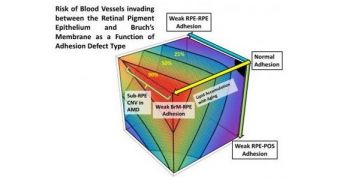Funny how science works! After 10 years of research and 9,000 papers published on the root cause of an eye disease called choroidal neovascularization (CNV), a shipping accident is what ultimately led a scientist to uncover a novel mechanism that may be underlying the condition.
Indiana University Biocomplexity Institute postdoctoral researcher Abbas Shirinifard was to receive a retina from an eye bank, but the vehicle that transported the sensitive biological material shook it considerably while en route. This lead to a significant breakthrough, the expert says.
Apparently, none of the scientists who've studied why blood vessels originating in the choroid suddenly break out into, and damage, the retina considered that retinal adhesion may play an important role.
“The simulations showed that reduced adhesion in the retina could indeed lead to its invasion by blood vessels,” says Shirinifard, quoted by EurekAlert. The expert is now developing computer models to determine which of three types of adhesion plays the most significant part.

 14 DAY TRIAL //
14 DAY TRIAL //